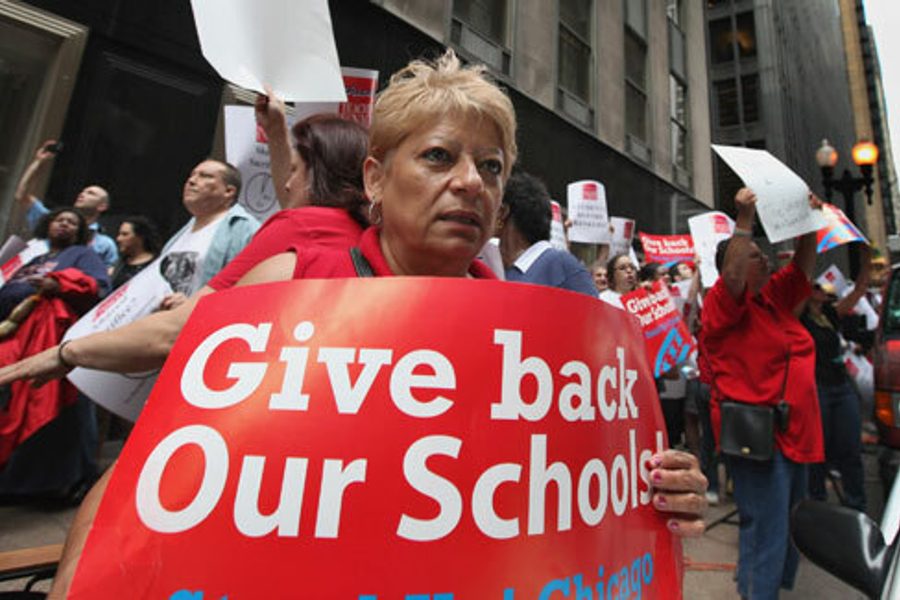
Schools these days can be dangerous places: a volatile mix of fiscal crisis, ideological tension and impressionable young minds. But our troubled public schools can teach us a lot when they push struggling teachers from the classroom to the picket line.
On Friday, stalled contract talks at Cincinnati State Technical & Community College compelled nearly 200 teachers to go on strike. Basic labor rights are at stake, with the administration “claiming it needs financial flexibility and teachers claiming the right to negotiate critical working conditions,” according to the Enquirer. The standoff appears to be a proxy battle over Ohio Senate Bill 5, which aims to strip away collective bargaining rights. The measure mirrors the infamous anti-union bill that rocked Wisconsin earlier this year, and parallels a national debate over public sector labor in which many educators have taken the helm.
On Wednesday, an “illegal” teachers’ strike in Tacoma, Wash., with a long history of union action behind it, finally drew to an end after 57 schools were shuttered for several days and teachers refused to go back to work, despite a court injunction. Their new contract requires concessions on both sides: Teachers got the district to hold off on pay cuts, but lost their bid for better teacher-to-student ratios.
A major flashpoint was the issue of teaching quality. According to Reuters, “the two sides agreed to establish a joint panel of teachers and school officials to set new teacher evaluation standards that would be used in conjunction with seniority to make future staffing reassignments.” Reading between the lines, it seems that the debate on teacher “accountability” will continue as corporate-style “school reform” zealots push for privatization-oriented policies that erode unions.
A similar standoff is playing out in Chicago, where teachers have clashed with Mayor Rahm Emanuel’s pilot initiative to institute a longer school day (though the conflict hasn’t reached a crisis point yet). The idea of tacking an extra 90 minutes onto students’ schedules has run into opposition primarily because it seems like a way to squeeze more labor out of teachers without paying them accordingly. Jason Erbentraut at The Huffington Post reports:
Last week the teachers union filed an unfair labor lawsuit against the mayor-appointed Chicago Board of Education. The suit claims that CPS has attempted to bribe and coerce schools into approving the longer school day pilot program — circumventing their existing contract by signing up for the longer work day.
Since CPS teachers were denied their contractually-obligated 4 percent raises — worth an estimated $100 million — earlier this year under the pretense that the system was too broke to afford them, many have wondered how the city is paying for pilot program incentives — which could cost as much as $30 million, depending on how many schools join.
It’s currently unclear how many schools will ultimately accept or reject the plan to stretch the workday, and it’s even less clear what would actually go into that extra classroom time: What about other investments to make those minutes worthwhile — more resources for instruction, enhanced curricula, fair compensation for teachers instead of just bonuses sprinkled on compliant schools?
Karen Lewis, head of the city’s teachers’ union, told NPR, “This is not about quantity, it’s about quality – -what is going on during the school day.”
Many might criticize the threat of a teachers’ strike as another way unions supposedly play politics with children’s education. But the recent teacher labor battles show that lawmakers have already turned education into a political pawn, and teachers are left to shoulder the burden of stultifying standardized tests, crippling bureaucracy and virulent anti-union sentiment. Radical education activists acknowledge that mainstream unions by nature operate on their own political agenda, and that mammoth unions like the American Federation of Teachers aren’t above cheating the rank-and-file to strike deals with the establishment.
But when they dare to draw the line on labor justice in the classroom, they’re teaching by example that a fair workplace is also a healthier learning environment.
Perhaps nowhere is that connection more apparent to both communities and educators than in post-Arab Spring Egypt, where teachers have marched off the job for the first time since 1951. They protest that the government has continually failed to address unfair wages and unfair “merit tests.” Cairo teacher Radi Salem Mohamed explained the frustrations of his profession to Ahram Online:
“We marched from my school to five other schools in the area, chanting for living wages for ourselves and decent education for the children,” Mohamed said.Mohamed explained that the ministry set near impossible conditions on teachers in order to release promised increases in wages.
“They want us to work a minimum of 18 days every month on a five days a week schedule. This means that we cannot take any sick or personal days off. That is not human.”
Cairo’s politics may not look anything like Tacoma’s or Chicago’s, but in all these cities, teachers and students struggle to bring democracy to the education system; they’ll only arrive at the answer by learning the hard way.

I hope you found this article important. Before you leave, I want to ask you to consider supporting our work with a donation. In These Times needs readers like you to help sustain our mission. We don’t depend on—or want—corporate advertising or deep-pocketed billionaires to fund our journalism. We’re supported by you, the reader, so we can focus on covering the issues that matter most to the progressive movement without fear or compromise.
Our work isn’t hidden behind a paywall because of people like you who support our journalism. We want to keep it that way. If you value the work we do and the movements we cover, please consider donating to In These Times.
Michelle Chen is a contributing writer at In These Times and The Nation, a contributing editor at Dissent and a co-producer of the “Belabored” podcast. She studies history at the CUNY Graduate Center. She tweets at @meeshellchen.







